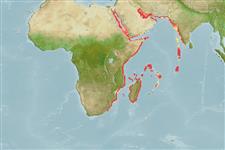>
Perciformes/Scorpaenoidei (Scorpionfishes) >
Scorpaenidae (Scorpionfishes or rockfishes) > Pteroinae
Etymology: Dendrochirus: Greek, dendron = tree + Greek, cheir = hands; with tree like marks (Ref. 45335); hemprichi: Named for the German naturalist and explorer Friedrich W. Hemprich, for his great contributions to the Zoology of the Red Sea, the type locality of the new species.
Eponymy: Dr Wilhelm Friedrich Hemprich (1796–1825) was a German physician, collector, naturalist and explorer. [...] (Ref. 128868), visit book page.
Environment: milieu / climate zone / profondeur / distribution range
Écologie
marin pelagic-neritic; profondeur 1 - 70 m (Ref. 116325), usually 1 - 3 m (Ref. 116325). Tropical
Western Indian Ocean: from northern Red Sea and Yemen, south along the east coast of Africa to the Seychelles, Madagascar and South Africa and east to Oman or the Arabian Gulf.
Taille / Poids / Âge
Maturité: Lm ? range ? - ? cm
Max length : 10.3 cm SL mâle / non sexé; (Ref. 116325)
Life cycle and mating behavior
Maturité | Reproduction | Frai | Œufs | Fécondité | Larves
Matsunuma, M., H. Motomura and S.V. Bogorodsky, 2017. Review of Indo-Pacific dwarf lionfishes (Scorpaenidae: Pteroinae) in the Dendrochirus brachypterus complex, with description of a new species from the western Indian Ocean. Ichthyological Research 64(4):369-414. (Ref. 116325)
Statut dans la liste rouge de l'IUCN (Ref. 130435: Version 2025-1)
Menace pour l'homme
Harmless
Utilisations par l'homme
Outils
Articles particuliers
Télécharger en XML
Sources Internet
Estimates based on models
Phylogenetic diversity index (Réf.
82804): PD
50 = 0.5039 [Uniqueness, from 0.5 = low to 2.0 = high].
Bayesian length-weight: a=0.01000 (0.00440 - 0.02274), b=3.02 (2.83 - 3.21), in cm total length, based on LWR estimates for this (Sub)family-body shape (Ref.
93245).
Niveau trophique (Réf.
69278): 3.7 ±0.6 se; based on size and trophs of closest relatives
Résilience (Réf.
120179): Haut, temps minimum de doublement de population inférieur à 15 mois (Preliminary K or Fecundity.).
Fishing Vulnerability (Ref.
59153): Low vulnerability (10 of 100).
🛈
